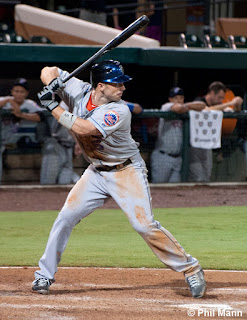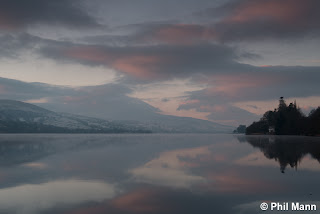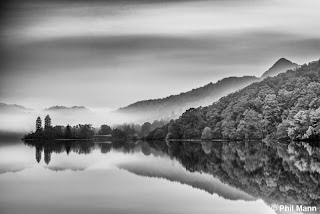I thought it would be interesting to look back at some of my favourite images from last year; if for no other reason than to consider whether I have actually progressed at all. The good thing about having posted so rarely over the last year is that only a small number will have been seen on here previously. Here they are (in no particular order):
In one of my previous blog entries, I mentioned that I had begun experimenting with a technique devised (as far as I am aware) by Niall Benvie. The technique involves using a white background and flash to create what is, in effect, a portable studio, allowing one to create studio like images of plants without disturbing them. I am far from perfecting the process but the image above is probably my best result so far; the subject suits the technique well. This is something I will continue to work on and that includes coming up with the most convenient combination of kit.

I believe I've written before about how much I love the Mersey Ferry. To me, it is the definitive symbol of my home town. It's existence has been threatened over the years but it continues to operate and now appears to have a firmly established role as a tourist attraction which should ensure it's future for many years to come. The ferry boats may have been refurbished and renamed but they are the same boats I travelled on as a kid when going to visit my Grandparents in Liverpool. It's easy then to see the emotional appeal this picture has for me and it has been my laptop wallpaper for much of the year for that very reason. For me, photography is still primarily about preserving memories and I can look at this photograph and remember vividly how I felt on that day and the kindness of the Mersey Ferries employee who invited me to stand beyond the barrier to get a better viewpoint as the ferry approached the landing stage.

This photograph represents a confluence of the desire to create memories and the development of my photographic technique. To begin with the latter; I've never really attempted much in the way of sports photography and this would undoubtedly have been improved with the use of a faster lens to throw the background out a little more. I also have other images where I have attempted to capture the relationship between the batter, catcher and umpire; these are ok but, again, a faster shutter speed would have helped. More practise needed so that means more trips to the States to watch baseball - shame! As for the memories; this was taken at a minor league ballpark during a wonderful family holiday in Florida. the batter is David Wright of the New York Mets; he was making his first rehab appearance after a back injury and it was pure chance that he was in the lineup for Port St.Lucie that evening. To be able to get to see him so close up was a thrill. Other things of note that evening; a lengthy rain delay where we got to hear just about every song about rain ever written, 'bark in the park' night where people were allowed to bring their dogs along and, last but by no means least, our first taste of Five Guys burgers and fries - simply the best!

I've recently expanded 'Landscape & Light' to include architecture; something I have always enjoyed photographing. Although most at home in a rural environment, I have always appreciated urban landscapes and there is a good deal of beauty to be found in architecture. A recent and, in my opinion, sympathetic addition to the Liverpool waterfront is the new Museum of Liverpool but, while it is striking from the outside, it is the interior staircase which really captures the eye. This is possibly the most obvious approach to photographing it although it's surprising how often people fail to look up. Incidentally, I am less impressed with the angular, black glass building now occupying Mann Island; it is not so much the building itself that I object to, rather it's position which has destroyed what had become an iconic scene from the Albert Docks across to the three graces.

Continuing the architectural theme, my next choice is this image taken from the Westminster Plaza hotel. This was actually taken with a compact camera (all I had with me at the time) and has not suffered too much as a result of that. The angle and the lighting provide a degree of dynamism with the main interest being provided by the contrast between the ultra modern hotel and the distant (double) view of Big Ben and the Houses of Parliament.

The previous image too very little effort to create. It was simply a question of being aware of my surroundings whilst waiting for the lift to arrive. This one, on the other hand, involved a considerable amount of effort. First, the planning; I was on a family holiday in Yorkshire and knew I had the following morning to myself as J and S were going riding. However, the forecast was for cloudy conditions so there was little point looking for open vistas and, on consulting my maps, I found what looked to be a promising river with falls. Finding it on the map was much easier than finding my way to it on foot and I ended up taking a circuitous route across high fells so that I could approach it from up river. This was far more exercise than I had planned for or desired but it probably did me good. When I arrived at this spot, the possibilities were immediately obvious but it was also clear that the ideal position would mean me standing in the river and, on this occasion, I was wearing walking boots rather than my wellies. I eventually arrived at a compromise which involved the camera being stationed rather precariously over the river on tripod with me sprawled across rocks to see into the viewfinder (now I see the point of those movable screens). Fortunately, neither me or, more importantly, the camera ended up in the water and the image was made. I would normally avoid what a wise photographer once referred to as 'dangly bits' but, in this case, I think the branches frame the waterfall nicely.

There are four or five images I could have used from this particular day in Snowdonia but I have settled for this and the following photograph. I had been asked to do a talk on landscape photography for
Frodsham and District Photographic Society and decided that I should base this around a single day 'in the field'; my planning and preparation, approach and how I might react to changing conditions and other challenges. This was that day and, in many respects, it turned out to be ideal as the day started bright, cold and frosty but, by early afternoon, had turned overcast and gloomy. Not a surprise then if I tell you that this photograph and the one below were from the morning. I had never been to this spot before but it looked promising on the map and that was part of the story I was aiming to tell. I will certainly be going back. I was blessed with a beautiful morning although there wasn't a cloud in the sky and I spent more than 3 hours and made several pictures I am very happy with, without going outside an area measuring about 200sq yards. One thing I have discovered over the years is that it can be counter-productive to try to do too much and that you can often get better results sticking to a small area, particularly one you know well.

As I've already mentioned, this image was made on the same morning as the one above but it is a very different scene. I suspect the wider view above is more likely to appeal to most people but, personally, I get a great deal of satisfaction from capturing a more intimate view; something which might be easily passed by and missed. I love the detail of the moss on the tree, the bracken and the lightly frosted grass and this detail is reproduced beautifully when printed on a matt art paper rather than the high gloss I am more accustomed to using.

This isn't necessarily my favourite wedding image of the year although I am very pleased with it. There are just so many pictures to choose from a year in which J and I have been fortunate enough to be a part of a number of wonderful occasions for some really lovely couples. The picture I have chosen to represent all of these weddings is from our last of 2011; the couple were delightful, their guests friendly and generous and the location ideal. A very natural portrait of a beautiful, young bridesmaid - nuff said!
The last picture, and the hardest to pick. I had set myself a limit of ten and, as I've not planned this out in advance, I find myself with two or three to choose one from. I am not going to go back on any of my other choices so this is it. This was taken on a wet, gloomy day in Anglesey. There is not a lot to do on Anglesey when the weather is really miserable and one of the few indoor attractions is
Plas Newydd so that is where we headed. As it happens, we spent a very pleasant few hours there and the rain eased enough for us to wander around the gardens. This was one of only two exposures I made; handheld at f2.8 and ISO 800. It is fine in colour but I feel the black and white conversion adds to the slightly mysterious and spooky atmosphere.
This, then is my top ten of 2011. I suppose I run the risk of you looking at these and deciding that, 'if this is the best he can do, he is not very good'. Still, it has been a useful exercise for me. As I said, this has not been planned out in advance and some of my choices have surprised me. The last one, for instance, might not had been included if I hadn't picked up a mounted print yesterday - the mount really finishes it off.When I started this post a few days ago, it was with the aim of seeing how much I have developed (sorry) over the year and, although I am not going to comment on my feelings about that here, what does interest me is what this choice tells me about my photography; it is clear to me now that, for me, photography is still a very personal thing and is about creating memories above all. There is only one image here (the first) which has been created for it's own sake; all of the others conjure up some specific memories of where I was and how I felt at the time. There is also, with the exception of the odd tweak, very little in the way of post processing to be seen. It's not that I think that is necessarily a bad thing; it's just not something that is important to me. If you like, for me, the means (photography and digital processing) is not more important than the end.



















































